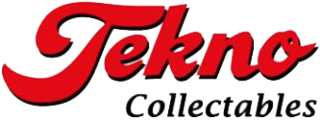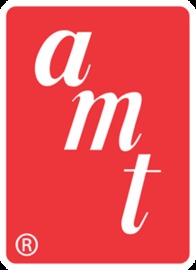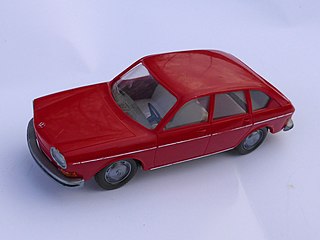
A model car, or toy car, is a miniature representation of an automobile. Other miniature motor vehicles, such as trucks, buses, or even ATVs, etc. are often included in this general category. Because many miniature vehicles were originally aimed at children as playthings, there is no precise difference between a model car and a toy car, yet the word 'model' implies either assembly required or the accurate rendering of an actual vehicle at smaller scale. The kit building hobby became popular through the 1950s, while the collecting of miniatures by adults started to gain momentum around 1970. Precision-detailed miniatures made specifically for adults are a significant part of the market since the mid-1980s.
The Franklin Mint is a private mint founded by Joseph Segel in 1964 in Wawa, Pennsylvania. The building is in Middletown Township.

Maisto is a brand of scale model vehicles introduced in 1990 and owned by May Cheong Group, a Chinese company founded in 1967 in Hong Kong by brothers P.Y. Ngan and Y.C Ngan. Head-quartered in Hong Kong, the brand has its offices in the United States, France and China. MCG also owns other model car brands such as former Italian brand Bburago and Polistil.

Schuco is a German manufacturing company founded in 1912 by Heinrich Müller and the businessman Heinrich Schreyer in Nuremberg, popularly known as Germany's toy capital. The company's specialty was making toy reproductions of cars and trucks in tin, plastic and die-cast. The company went bankrupt in 1976 but was reorganized in 1993 and then totally independent again by 1996.
AUTOart is a Hong Kong-based scale model car line manufactured by Gateway Autoart Ltd. and sold by AA Collection Ltd.

Bburago is a manufacturing company of toys and die-cast scale model cars formerly based in Italy. The company was based in Burago di Molgora, where all products were made from 1974 to 2005. At the height of its popularity, Bburago's main competitors were Politoys and Maisto, the latter of which was to become dominant in the 1:18 market segment around 2000.

Tekno is a Danish manufacturing company of scale model trucks and other vehicles, currently headquartered in De Lier, Netherlands. Originally established and based in Copenhagen, Tekno began manufacturing construction toys in 1928 and model vehicles immediately after World War II, selling 1 million a year during its peak.

Jo-Han was a manufacturer of plastic scale promotional model cars and kits originally based in Detroit. The company was founded in 1947 by tool and die maker John Hanley a year before West Gallogly's competing company AMT was formed and about the same time as PMC. After changing ownership a few times, Jo-Han models were sporadically manufactured by Okey Spaulding in Covington, Kentucky, but apparently none have been offered for several years.

Aluminum Model Toys (AMT) is a toy manufacturing brand founded in Troy, Michigan, in 1948 by West Gallogly Sr. AMT became known for manufacturing 1/25 scale plastic automobile dealer promotional model cars and friction motor models, and pioneered the annual 3-in-1 model kit buildable in stock, custom, or hot-rod versions. The company made a two-way deal in 1966 with Desilu Productions to produce a line of Star Trek models and to produce a 3/4 scale exterior and interior filming set of the Galileo shuttlecraft. It was also known for producing model trucks and movie and TV vehicles.

Conrad GmbH is a German manufacturer of diecast scale model trucks, primarily in 1:50 scale for use both as toys and promotional models by heavy equipment manufacturers. Conrad is one of the few European diecast companies which have not outsourced production to China or elsewhere in Asia. Conrad Modelle is headquartered in Kalchreuth, just northeast of Nuremberg.
Nürnberger Zinkdruckguß-Modelle GmbH is a German manufacturer of diecast scale models primarily in 1:50 scale for use both as toys and promotional models mainly by heavy transport and construction equipment manufacturers.

Polistil S.p.A. is an Italian toy brand and former manufacturing company headquartered in Milan, with production center in Chiari, near Brescia. Polistil specialized in die-cast and plastic scale model vehicles of all sizes.

Model Products Corporation, usually known by its acronym, MPC, is an American brand and former manufacturing company of plastic scale model kits and pre-assembled promotional models of cars that were popular in the 1960s and 1970s. MPC's main competition was model kits made by AMT, Jo-Han, Revell, and Monogram.

Gama is a German maker of toys, usually cars and trucks, dating from before World War I. The company is headquartered in Fürth, Bavaria, near Nürnberg, a traditional German toymaking center. Other German companies that competed with Gama Toys were Schuco Modell and Conrad Models.

Cursor Modell was a German company making models of antique and modern German vehicles. It is best known for its plastic replicas of vehicles mainly of the era 1880 to about 1920, produced for, and sold in, the Daimler-Benz museum in Stuttgart.
Holand Oto is a Dutch manufacturing company based in Weert that produces diecast scale model cars and trucks. The company was established in 1959 in Heerlen as "Bestbox", then changing its name to "Efsi" in early 1970s.
Dugu Miniautotoys was a brand of diecast metal models, mostly in 1:43 scale, made in Varallo Sesia, Vercelli Province, Piedmont, Italy, north of Turin and west of Lake Orto. The company made models for the Carlo Biscaretti di Ruffia Automobile Museum in Turin. They were made from approximately 1961–1975, and perhaps a few years longer.

Sablon was a Belgian company near Brussels that made diecast zamac toy cars in the late 1960s and early 1970s. Models were mostly in 1:43 scale and were similar in concept to Dinky Toys or Solido.
Rétrospectives Automobiles Miniatures was a French manufacturing company that made diecast scale model collector vehicles mostly of classic French automobiles in 1:43 scale. The acronym was seen on packaging without the periods between the letters of the acronym, but on some of the vehicle bases with the punctuation. "J.M.K." was a further acronym that stood for the three founding members of the company: M. Jarry, Henri Malartre and M. Koch. Though the models were often known simply as RAMI, the full name of the company was RAMI by J.M.K.
Ziss-Modell, originally also called R. W. Modell or Wittek Modell were 'brand' names of the German Mini-Auto firm which made diecast metal classic and contemporary vehicles from the 1960s through the late 1970s. Later, use of the Mini-Auto name largely disappeared and the models were mainly known as Ziss or R. W. Modell. The company was based in Lintorf.












